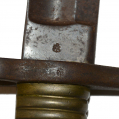site search
online catalog
CIVIL WAR IMPORT SWORD BAYONET FOR THE LIEGE RIFLE WITH SABER BAYONET, AKA BRAZILIAN LIGHT MINIE

$125.00 SOLD
Quantity Available: None
Item Code: 2024-1181
These are straight-bladed sword bayonets with iron guard and brass, ribbed grips, about 28 ½” long overall with 23 ¾” blade featuring a wide, stopped primary fuller, narrow back edge fuller, and a 6” false edge, with the guard about 4 ½” tall and the grip slotted for a bayonet stud and fitted with spring lock and release button. The blade has a good edge and point, showing gray mixed with darker gray areas and light brown spotting that might clear up a bit with a careful, non-aggressive cleaning. The brass grip retains well-defined ribs. The locking button and spring are in place, showing faded blue and brown. The guard shows gray and brown with some shallow pitting. Both muzzle ring and quillon have flat disk finials. The blade has a very clear S&K stamp on the reverse ricasso, and a D[anchor]C stamp on the obverse with matching stamp on the side of the guard just underneath. The top of the pommel has stamped number crossing the end of the blade tang that has a “3” followed by space for another numeral that is light, followed by “06,” all of which is a mating number that would also be on the bayonet lug of the rifle since there was some filing and hand fitting necessary in the assembly.
These were imported into the U.S. along with the so-called “Brazilian Light Minie Rifle” made by O.P. Drissen & Company of Liege, hence the D[anchor]C marks (“Drissen & Cie.”) with the S&K stamp of Solingen firm Schnitzler & Kirschbaum, indicating Drissen’s source for the bayonet blades if not the complete bayonets. There is still debate on the proper designation of the rifles. The U.S. Ordnance Dept. seems to have referred to them as “Rifles, Liege, saber bayonet, caliber .577.” Collectors more often refer to them as the “Brazilian Light Minie,” deriving from the belief these were made on a Brazilian contract diverted to the U.S. by American purchasing agents or arms merchants, with some contending they were Brazilian navy rifles and were brought in by Herman Boker of New York. Others point to William Syrus and Brothers, or to C.K. Garrison as importers, with the latter having a contract for 5,800 “minie rifles of Liege pattern with saber bayonets,” though he could substitute rifle-muskets. Lastly, John Pondir of Philadelphia, who had an 1861 contract for 10,000 .58 Cal. Minie rifles with sword bayonets, reportedly had them made in Liege and delivered 11,372 by October 1862, with extra guns purchased on the open market. In any case, they may lurk in some records as Enfield or Belgian short rifles.
Whatever the proper designation of the pattern, the rifles are an attractive blend of Enfield styling with French style bands and tall Belgian style rear sights. Some bear Ohio stamps; others show up in the hands of various Union troops in period photographs; and, there is some evidence a few even made their way into the hands of western cavalry, minus the bayonets. Some also likely made their way into Confederate hands by capture: one with a broken muzzle appears on the ground behind a slain Confederate soldier photographed in earthworks at Fort Mahone at Petersburg, killed in the fighting of April 2, 1865. [sr][ph:L]
~~~~~~~~~~~~~~~~~~~~~~~~~~~~~~~~~~~
THIS ITEM, AS WITH ALL OTHER ITEMS AVAILABLE ON OUR WEB SITE,
MAY BE PURCHASED THROUGH OUR LAYAWAY PROGRAM.
CLICK HERE FOR OUR POLICIES AND TERMS.
THANK YOU!
Inquire About CIVIL WAR IMPORT SWORD BAYONET FOR THE LIEGE RIFLE WITH SABER BAYONET, AKA BRAZILIAN LIGHT MINIE
For inquiries, please email us at [email protected]
Most Popular
Historical Firearms Stolen From The National Civil War Museum In Harrisburg, Pa »
Theft From Gravesite Of Gen. John Reynolds »
Selection Of Unframed Prints By Don Troiani »
Fine Condition Brass Infantry Bugle Insignia »
Wonderful Condition Original Confederate-Manufactured Kepi For A Drummer Boy Or Child »
featured item
HISTORICAL FIREARMS STOLEN FROM THE NATIONAL CIVIL WAR MUSEUM IN HARRISBURG, PA
Please click on the photograph above to view a flyer containing information regarding a Model 1860 Henry Rifle and pair of cased presentation Colt Revolvers identified to Secretary of War Simon Cameron which were stolen from the museum on February… . Learn More »













